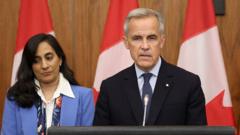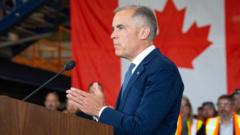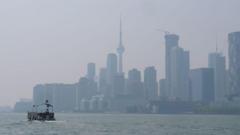Residents are taking precautions as city temperatures reach highs not seen in years.
Toronto Gripped by Unprecedented Heat Wave

Toronto Gripped by Unprecedented Heat Wave
Extreme temperatures lead to health alerts and school closures in Canada's largest city.
The intense heat gripping parts of northeastern North America has made its way to Toronto, prompting health concerns and significant public reactions. With temperatures soaring to an alarming 36 degrees Celsius, or 97 degrees Fahrenheit, residents have been warned to stay cool and hydrated as the city faces the warmest weather it has experienced since 2016.
As the mercury climbed, many sought refuge indoors, contributing to the closure of numerous public schools due to extreme heat regulations that hinder lifeguarding activities. This decision sparked frustration among parents and community members, who were looking forward to summer swimming opportunities. In response, Toronto Mayor Olivia Chow acknowledged the situation, pledging to increase lifeguard staff and improve cooling facilities for future heat waves.
The oppressive weather has decimated the usual ebb and flow of summer activity in the city, with public pools intermittently closing due to labor safety concerns, and officials advising residents to limit outdoor exposure. With a forecast of continued high humidity levels, medical professionals have emphasized the need for everyone to remain vigilant regarding the symptoms of heat exhaustion, which can manifest in nausea and fatigue.
Looking ahead, relief may be on the horizon, with weather predictions suggesting a drop in temperatures on Wednesday to more seasonal levels. However, many hold lingering concerns about the city’s infrastructure in coping with future heat events. Approximately 30 percent of Toronto's schools are equipped with air conditioning, contrasting sharply with the 90 percent rate observed in U.S. homes.
Cities like Ottawa and Montreal are similarly grappling with unprecedented heat conditions, raising broader discussions on climate adaptation and community safety as the warmer months advance. As summer approaches, the effects of climate change increasingly become central to local governance and public health considerations.
As the mercury climbed, many sought refuge indoors, contributing to the closure of numerous public schools due to extreme heat regulations that hinder lifeguarding activities. This decision sparked frustration among parents and community members, who were looking forward to summer swimming opportunities. In response, Toronto Mayor Olivia Chow acknowledged the situation, pledging to increase lifeguard staff and improve cooling facilities for future heat waves.
The oppressive weather has decimated the usual ebb and flow of summer activity in the city, with public pools intermittently closing due to labor safety concerns, and officials advising residents to limit outdoor exposure. With a forecast of continued high humidity levels, medical professionals have emphasized the need for everyone to remain vigilant regarding the symptoms of heat exhaustion, which can manifest in nausea and fatigue.
Looking ahead, relief may be on the horizon, with weather predictions suggesting a drop in temperatures on Wednesday to more seasonal levels. However, many hold lingering concerns about the city’s infrastructure in coping with future heat events. Approximately 30 percent of Toronto's schools are equipped with air conditioning, contrasting sharply with the 90 percent rate observed in U.S. homes.
Cities like Ottawa and Montreal are similarly grappling with unprecedented heat conditions, raising broader discussions on climate adaptation and community safety as the warmer months advance. As summer approaches, the effects of climate change increasingly become central to local governance and public health considerations.




















